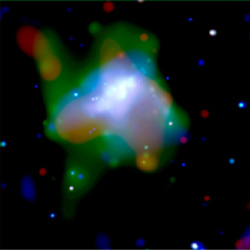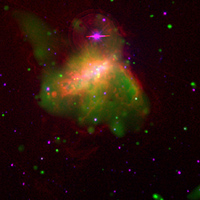July 23, 2002
RELEASE: 02-134
Astronomers have discovered that a nearby dwarf galaxy is spewing oxygen and other "heavy" elements into intergalactic space. This observation from NASA's Chandra X-ray Observatory supports the idea that dwarf galaxies may be responsible for most of the heavy elements between the galaxies.
Despite comprising only a very small fraction of the mass of the universe, so-called heavy elements - everything other than hydrogen and helium -- are essential for the formation of planets and can greatly influence astronomical phenomena, including the rate at which galaxies form.
A team led by Crystal Martin of the University of California, Santa Barbara, observed the dwarf galaxy NGC 1569 using Chandra. As reported in an article to be published in The Astrophysical Journal, they found that huge quantities of oxygen and other heavy elements are escaping from the galaxy in bubbles of multimillion-degree gases that are thousands of light years in diameter
"Dwarf galaxies are much smaller than ordinary galaxies like our Milky Way and much more common," said Martin. "Because of their small mass, they have relatively low gravity and matter can escape more easily from dwarfs than normal galaxies. This makes them very important in understanding how the universe was seeded with various elements."
Scientists have speculated that heavy elements escaping from dwarf galaxies in the early universe could play a dominant role in enriching the intergalactic gas from which other galaxies form. Enriched gas cools more quickly, so the rate and manner of formation of new galaxies in the early universe would have been strongly affected by this process.
"With Chandra it was possible to test these ideas," said Henry Kobulnicky of the University of Wisconsin, Madison, a member of the research team. "We could trace the distribution of oxygen and other elements in the galaxy and determine how much of this matter is escaping from the galaxy."
NGC 1569 is a good case study because it is only about 7 million light years from Earth, and for the last 10 million to 20 million years it has been undergoing a burst of star formation and supernova explosions, perhaps triggered by a collision with a massive gas cloud. The supernovas eject oxygen and other heavy elements at high velocity into the gas in the galaxy, heating it to millions of degrees. Hot gas boils off the gaseous disk of the galaxy and expands outward at speeds of hundreds of thousands of miles per hour.
The team found large hot bubbles extending above and below a disk of gas along the equator of the galaxy. The measured concentration of oxygen, neon, magnesium, and silicon showed that the elements from thousands of supernovas are evaporating out of the galaxy, carrying much of the surrounding gas with them. The astronomers estimate the bubbles are carrying away an amount of oxygen equivalent to that found in about 3 million suns.
In addition to Martin and Kobulnicky, Timothy Heckman of John Hopkins University in Baltimore, was part of the team that observed NGC 1569 for 27.4 hours using the Advanced CCD Imaging Spectrometer (ACIS) on April 11, 2001. ACIS was built for NASA by Penn State, University Park, and the Massachusetts Institute of Technology, Cambridge, Mass. NASA's Marshall Space Flight Center, Huntsville, Ala., manages the Chandra program for the Office of Space Science,n Washington. TRW, Inc., Redondo Beach, Calif., is the prime contractor for the spacecraft. The Smithsonian's Chandra X-ray Center controls science and flight operations from Cambridge, Mass.
MEDIA CONTACTS
Dolores Beasley
Headquarters, Washington
Phone: 202-358-1753
Steve Roy
Marshall Space Flight Center, Huntsville, AL
Phone: 256-544-6535
Megan Watzke
Chandra X-ray Observatory Center, CfA, Cambridge, MA
Phone: 617-496-7998
cxcpress@cfa.harvard.edu




